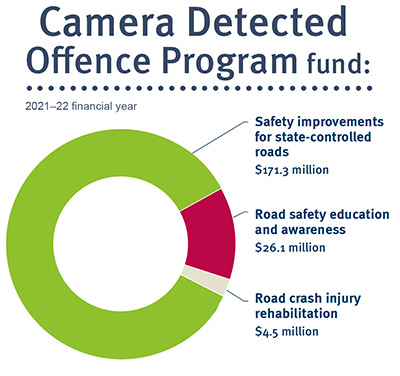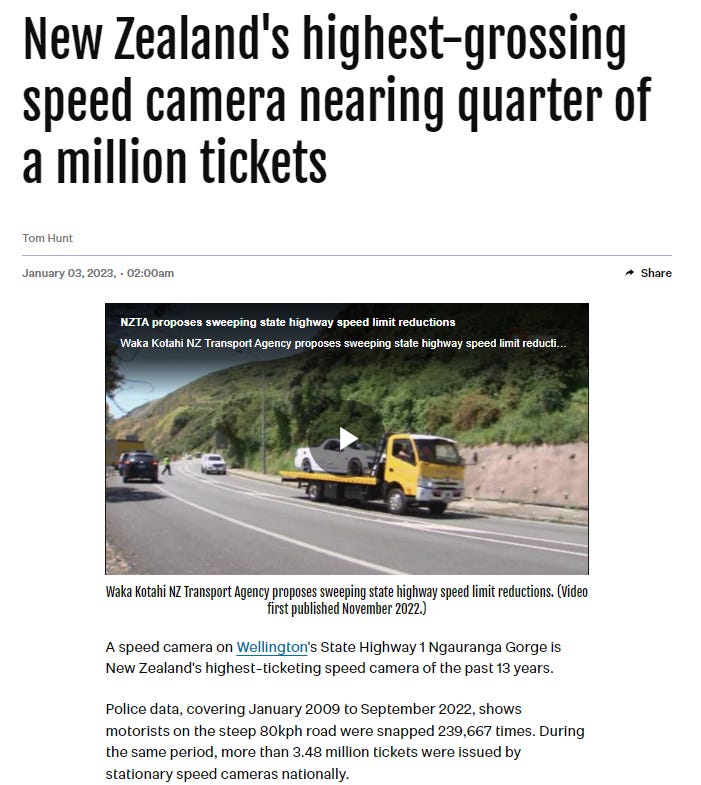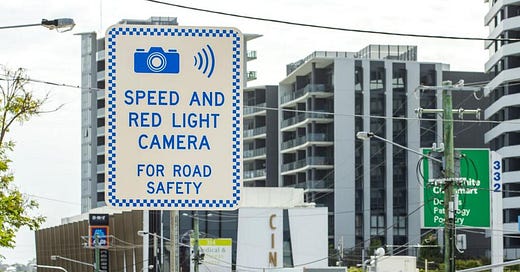Some fine ideas for making Aotearoa safer
Aotearoa has one of the worst road safety records in the developed world. Australia is doing quite a bit better. What can we learn from our Aussie cousins?
In Aotearoa, driving is often perceived in public discourse as a right, not the privilege that it is. Driver licensing, by its very nature, requires a prescribed standard of driving skill and knowledge of the road rules in order to keep all road users - from oneself to other drivers through to public transport passengers and people on foot and bike - as safe as possible. To this end, there are sanctions available, including fines, to incentivise safe driving and penalise those who do not drive safely. The oft-held tenet that traffic fines is revenue raising is strictly speaking true as money is collected. But this ignores the fact that the only way drivers are raising revenue is by them breaking the law. We don’t question punishments for behaviour that could injure or kill people except, apparently, when those behaviours are committed behind the wheel of a vehicle.

But for fines to have an effect on driver behaviour, they have to have a deterrent effect. And this is an area where Aotearoa fails miserably in comparison to our large neighbour to the west, Australia.
A quick Trans Tasman deterrence calculator
What follows is a comparison between Aotearoa and my current residence in exile - at least for the duration of the Coalition of Clowns - in Queensland. The Queensland fines are from 1 July 2024 as Queensland, unlike Aotearoa, increases fines every year in line with inflation.
[Amounts are in local currency. As at 18 June 2024, $NZ1 = $A0.93.]
Speeding 5km/h over the speed limit
In Aotearoa - $0 as there is in effect a 7km/h tolerance built into enforcement
In Queensland - $322 and 1 demerit point. There is zero tolerance for speeding in Queensland (and more on demerit points later)
Speeding 31km/h over the speed limit
In Aotearoa - $300 and no demerit points if caught by a speed camera
In Queensland - $1,210 and 6 demerit points
Mobile phone use while driving
In Aotearoa - $150 and 20 demerit points
In Queensland - $1,210 and 4 demerit points
Not wearing a seatbelt
In Aotearoa - $150 and 0 demerit points
In Queensland - $1,210 and 4 demerit points
Running a red traffic light
In Aotearoa - $150 and 0 demerit points
In Queensland (including running an amber light) - $645 and 3 demerit points
Parking offences
In Aotearoa - from $12
In Brisbane - $120
As you can see, there are huge differences in both the level of fines and a number of key safety offences where there are no demerit points in Aotearoa - such as running a red light.
But the issue goes broader than this as there are striking differences between the mechanics of the demerit point regimes between Queensland and Aotearoa.
A tale of two demerit point regimes
Queensland
If you get 12 or more demerit points within a 3 year period on a Queensland open licence, you have to choose to either:
have your open licence suspended for a requisite period (12-15 demerit points = 3 months; 16-19 demerit points = 4 month suspension; 20+ demerit points = 5 months), or
agree to continue driving under a period of good driving behaviour for 1 year.
If you choose to continue driving under a good driving behaviour period for 1 year, you can keep your current licence. If you get 2 or more demerit points during the good driving behaviour period, your licence will be suspended for double the suspension period that would have applied if you had chosen the suspension period originally (e.g. for an original 5 month suspension, your new licence suspension will be 10 months).
But wait, there’s more. In Queensland, double demerit points apply for certain second or subsequent offences committed within a year of the previous offence, including.
speeding more than 20km/h over the speed limit
mobile phone offences
driver seatbelt offences
Unlike other states and territories of Australia, in Queensland double demerit points apply year around, not just during holiday periods.
For a mobile phone offences (and it is illegal to even touch your mobile phone while driving in Queensland) with double demerit points, two mobile phone offences in a year triggers a licence suspension or good driving behaviour period.
And if you’re found driving while suspended, you’ll be charged with unlicensed driving and need to appear in court.
Aotearoa
If you accumulate 100 or more demerit points in any two-year period, your licence will be suspended for three months. As speed camera, seat belt and red-light running offences don’t have demerit points in Aotearoa, only fines apply for these offences. It would take five mobile phone offences in two years (versus two offences in one year in Queensland) to trigger a three-month licence suspension. After a licence suspension is over, you can automatically regain your licence and all the previous demerit points leading to the licence suspension are cancelled. Similarly, if a court disqualifies you for a period of six months or more, any active demerit points recorded on your licence record at the time will be cancelled and will no longer contribute to your active demerit point total.
Enforcement
What makes this situation even worse are the significant differences in traffic and parking enforcement between Aotearoa and Australia. In Aotearoa, parking fines are so low that it is a loss maker for road controlling authorities to enforce parking restrictions, most extremely for non-paid parking offences.
But, more importantly, the deterrence of high fines needs to be backed up with high enforcement of fines. If you run little risk of being caught, then no level of fines will have a significant deterrence effect.
In Queensland, speed, red light camera, seatbelt and mobile phone use enforcement is both highly visible and subject to high levels of fines and demerit points. In the 2022-2023 financial year, there were 558,570 mobile speed camera infringements, over 78 per cent of which were for less than 13 km/h over the speed limit.
But this doesn’t stop the apparent paradox where only 47 per cent of Queenslanders surveyed agreed with the statement ‘Low-level speeding is a major contributor to crashes’ while 90 per cent agreed with the statement ‘The faster you drive, the more severe the crash’1. In the same survey, 54 per cent of respondents self-identified as low level speeders who travel 1-10 km/h over the speed limit for more than 10 per cent of driving time.

Even with this apparent cognitive disconnect, an important element of the Queensland traffic camera program is the legislative requirement under the Transport Operations (Road Use Management) Act 1995 for proceeds of traffic camera fines to be spent on:
road safety education and awareness
improving road-safe practices and behaviours
rehabilitating persons who have been injured in a road crash.
As per the graphic above, the Camera Detected Offence Program enabled $171.3 million to be spent on safety improvements on Queensland’s 33,000 kilometres of state-controlled roads in the 2021-2022 financial year.
In Aotearoa, money from speed camera fines goes into the Government Consolidated Fund, meaning there is no direct connection between payer and benefit.

Of interest is there are more mobile speed camera offences detected in Aotearoa2 (608,029 in 2023) than in Queensland (558,570 in FY 2022-2023) even though there are a lot fewer cameras in Aotearoa. This is explained by a lot more cameras in Queensland (up to 3,500) versus around 200 in Aotearoa, detecting a lot fewer offences. There are 14,411 vehicles per speed camera offence and an astounding 152,630 vehicles per red light camera offence detection in Queensland. This bears out my experience of living in Queensland where speed and red light compliance is very high when compared to my experience of living in Aotearoa.
And this also bears itself out in the safety statistics. In 2023, 341 people died in road crashes in Aotearoa while 276 people died in Queensland. Adjusting for population3, Queensland’s per capita road death rate is 25 per cent below Aotearoa’s.
Final thoughts
Compared to Queensland, Aotearoa’s traffic and parking fines are very low and are a poor deterrent to bad driving and parking behaviour.
Queensland’s demerit point system is vastly more effective than Aotearoa’s, especially for speeding, mobile phone use and red light running.
Both Aotearoa and Queensland drivers have the same cognitive disconnect between their own speeding and the risk and severity of crashes as speeds increase.
Enforcement is much more visible (and comes with much more severe consequences) in Queensland than in Aotearoa but detects fewer offences due to much higher compliance rates.
Queensland makes no apology for reinvesting traffic offence camera revenue in road safety whereas in Aotearoa, this goes directly into the Consolidated Fund.
In the end, the combination of higher fines, a much tougher demerit point regime and visible and frequent enforcement contributes to a significantly lower death toll on the road network in Queensland when compared to Aotearoa.
As an aside, with transport revenues severely strained in Aotearoa, is it such a bad thing to collect more revenue from traffic offenders, which would deter bad driving (along with a higher risk of licence suspension)? This would both contribute to safer roads and provide more revenue to make roads safer.
This piece only covers a few elements of road safety. There are many other that are equally if not more important such as safe, survivable speeds and streets designed for everyone - on foot, bike, public transport or in a car, truck or van.
Department of Transport and Main Road Annual Report 2022-2023, appendix 4, page 223
Aotearoa population 5,228,100; Queensland population 5,528,292 - both for 2023





Thank you for such a clear comparison! I always wonder whether we shoukd all take a theory and simulation test (if not practical, too) every time we update the photo on out licences. Pre-emptive education v. post-transgression enforcement?
Also, I'm not sure whether this is still the case, but when I lived in Sydney (2001-2004) the NSW rules also covered licenced passengers. E.g. if there are 4 ppl with licences in a car, all drunk and unbelted, every one of them would get fined on the basis that they are all obliged to ensure that the car is being operated safely, not just the driver.
Fascinating numbers. Not a surprise, though so disappointing. I also don’t understand why there isn’t compulsory third-party insurance for drivers in New Zealand. It would prevent inexperienced drivers getting very powerful cars that they can’t control. It would also mean that people who were caught up in thetheir accidents are compensated.